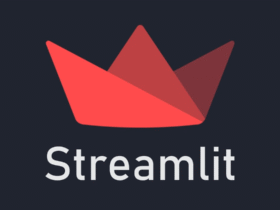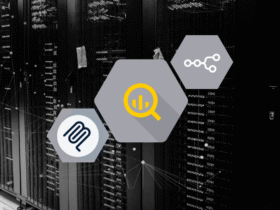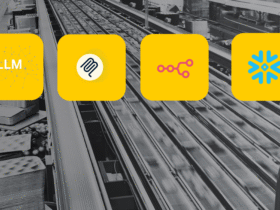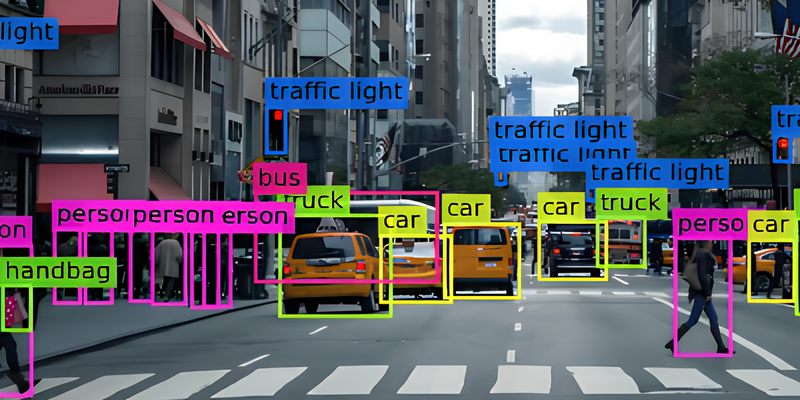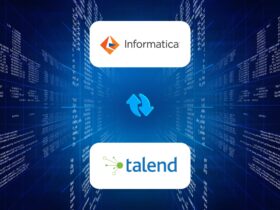Role of Annotation in the Field of Computer Vision
Annotations play an important role in computer vision, which is the ability of computers to gain a high-level understanding from digital images or videos. Annotations are essentially labels or metadata added to images to provide information about their content, which is then used to train machine learning models. This process is called image annotation.
Image annotation involves labelling images with specific information about the objects, features, or scenes within them. This information can include the location, shape, size, color, and other characteristics of the objects. The goal of image annotation is to enable machines to recognize and understand the content of images in a way that is similar to how humans do.
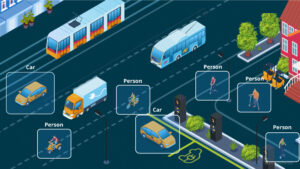
Fig: 1: Image Annotation
Challenges of manual Annotation
Complications in manually annotating visual data:
- It is Time-consuming and labor-intensive, especially for large datasets.
- Inconsistent and subjective, with different annotators interpreting data differently.
- Scalability limitations which make it impractical for large datasets.
- High costs and inefficiencies as compared to automated methods.
- Quality control issues: Ensuring high-quality annotations requires careful oversight and quality assurance measures, which can add further complexity to the process.
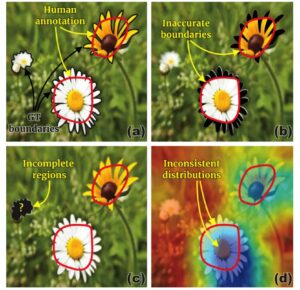
Fig: 2: Challenges in Manual Annotation
Auto Annotation
WE can overcome the major challenges in Manual annotation by automating the process i.e., “Auto Annotation. “
Automatic annotation refers to the process where a computer system automatically assigns metadata, such as bounding boxes or masks, to digital images without human intervention.
This process is crucial in computer vision tasks, as it speeds up the annotation and improve efficiency in training machine learning models. Automatic image annotation often utilizes deep learning models to create preliminary annotations, enhancing the accuracy and speed of the annotation.
Automatic annotation plays a significant role in streamlining the image annotation process, making it more efficient and scalable for various computer vision applications.
Architecture

Fig: 3: Auto Annotation Architecture
Let’s go through the architecture in detail:
In this process, we leverage a combination of YOLO v8 and SAM for image annotation. When a set of images is passed through this function, they are first processed by our custom YOLO v8 model, which has been pre-trained on the specific classes we aim to annotate. The YOLO v8 model detects these classes in the images and generates class IDs and bounding boxes to localize them. These detection coordinates are then fed into SAM, which helps in masking the localized objects. Finally, we extract the class IDs from YOLO and the corresponding segmentation annotations from SAM, storing the results in a text file.
Auto Annotation on Custom Classes (Pothole Dataset)
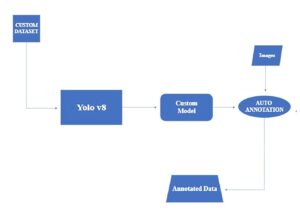
Fig: 4: Work Flow Auto Annotation with Custom Classes
The above flowchart illustrates our implementation of Auto Annotation using a model trained with a custom dataset. Initially, we used a custom dataset focused on potholes. Next, we fine-tuned YOLO v8 with this dataset, resulting in a model specifically tailored to our custom class and data. This fine-tuned model was then integrated into the auto annotation pipeline along with the images requiring annotation. The final output consists of text files containing the annotation data for the respective images, formatted according to YOLO v8 standards.
Results
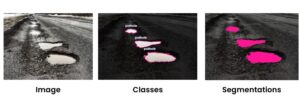
Fig: 5: The Output
The above image showcases the successful application of our auto annotation process. In the first frame, we see the original image of a road with several potholes. The second frame demonstrates the detection of potholes, where our fine-tuned YOLO v8 model accurately identifies and labels each pothole class. The third frame highlights the segmentation results, where the detected potholes are precisely masked in pink, indicating the accurate localization and segmentation achieved through SAM.
These results confirm the effectiveness of our auto annotation pipeline which reduces 90% of the annotation tasks for manual annotators providing high-quality annotations, leading to significant improvements in productivity, accuracy and cost efficiency.
Use Cases
Medical Field
Auto annotation can be utilized for identifying and annotating medical images, such as detecting tumors in radiology scans or segmenting anatomical structures in MRI images.
Retail Sector
In retail, it enhances inventory management by accurately labelling products on shelves, facilitating automated stock tracking, and improving product recommendations.
Automotive Industry
For autonomous vehicles, auto annotation is crucial for training models to recognize and respond to various objects and obstacles, accelerating the development of self-driving algorithms.
Benefits of Auto Annotation
Efficiency
It provides a large volume of accurately labelled data quickly, essential for training robust machine learning models and leading to better performance and faster deployment.
Consistency
Ensures uniform labelling across datasets, eliminating variability from manual annotations.
Scalability
Allows rapid processing of large datasets, making it practical to handle the growing volume of data needed for advanced models.
Cost Reduction
Minimizes the need for extensive manual labor, reducing costs and saving time, allowing resources to be used more efficiently.
Conclusion
In conclusion, this auto annotation system is a powerful tool for generating high-quality annotations for a wide range of custom classes. This auto annotation project has been a great success in streamlining the data labelling process for machine learning models. The result of the project demonstrates that by automating the annotation of images we have been able to significantly reduce the time and resources required compared to manual labelling.
References
- Segment Anything – 5 Apr 2023 [Alexander Kirillov, Eric Mintun, Nikhila Ravi, Hanzi Mao Chloe Rolland, Laura Gustafson, Tete Xiao, Spencer Whitehead]
- Segment Anything Model Research by Meta AI
- Ultralytics YOLOv8 Docs
- https://docs.ultralytics.com/datasets/detect/#coco-dataset-format-to-yolo-format
- https://docs.roboflow.com/annotate/annotation-tools
- https://docs.roboflow.com/workspaces/roboflow-workspaces


